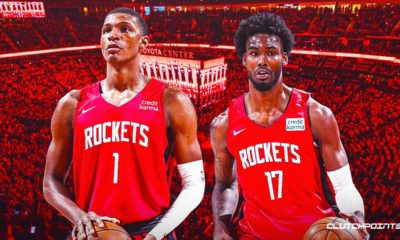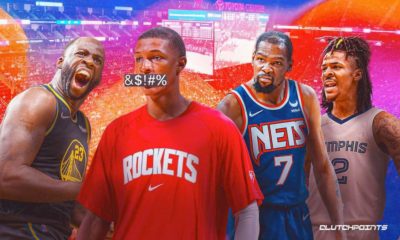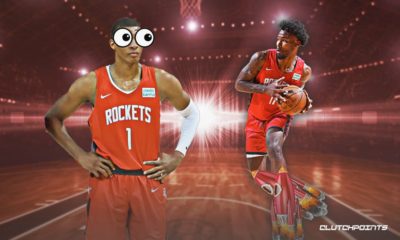Rockets
How Clint Capela’s impact has suffered against the Warriors
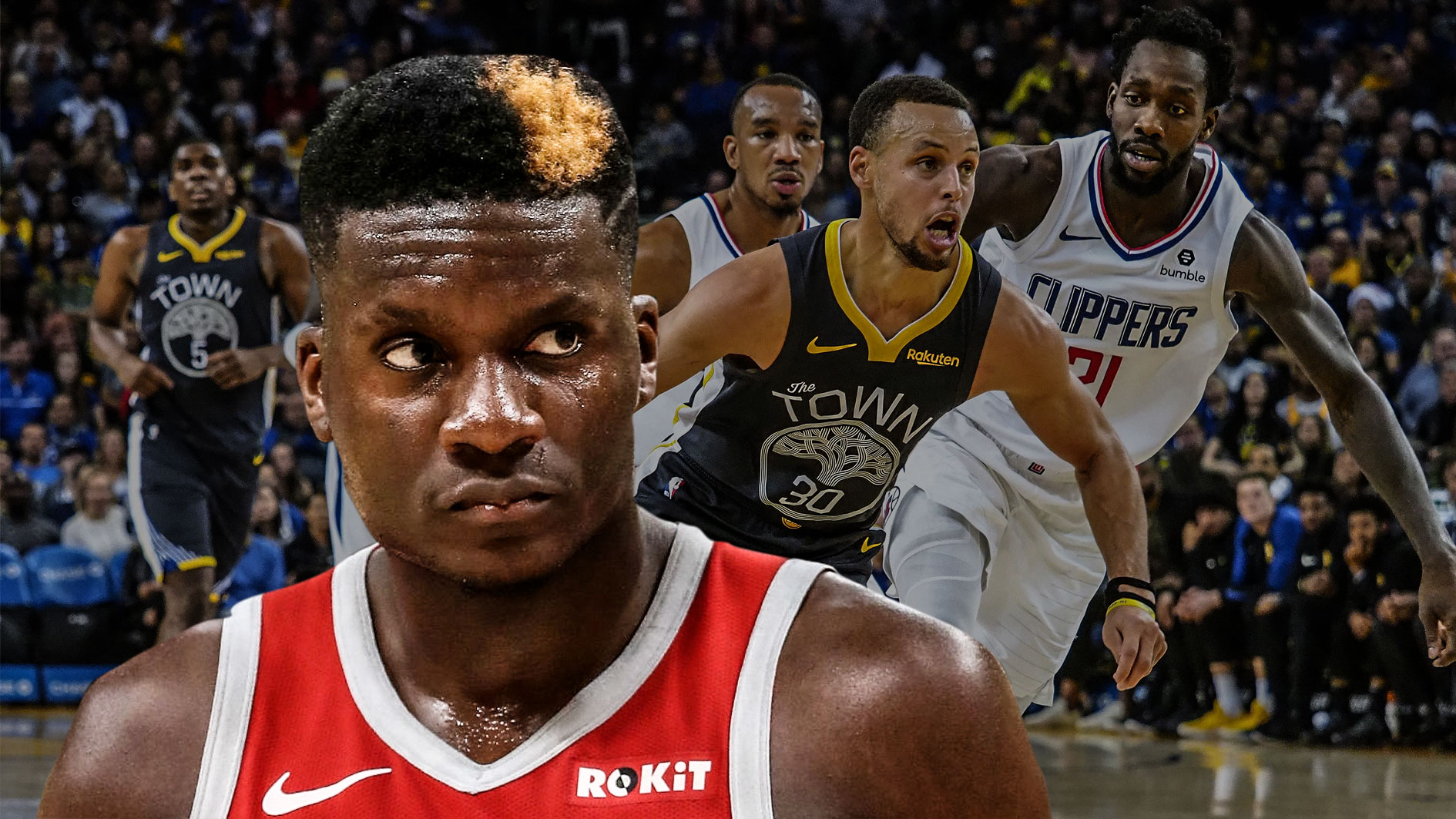
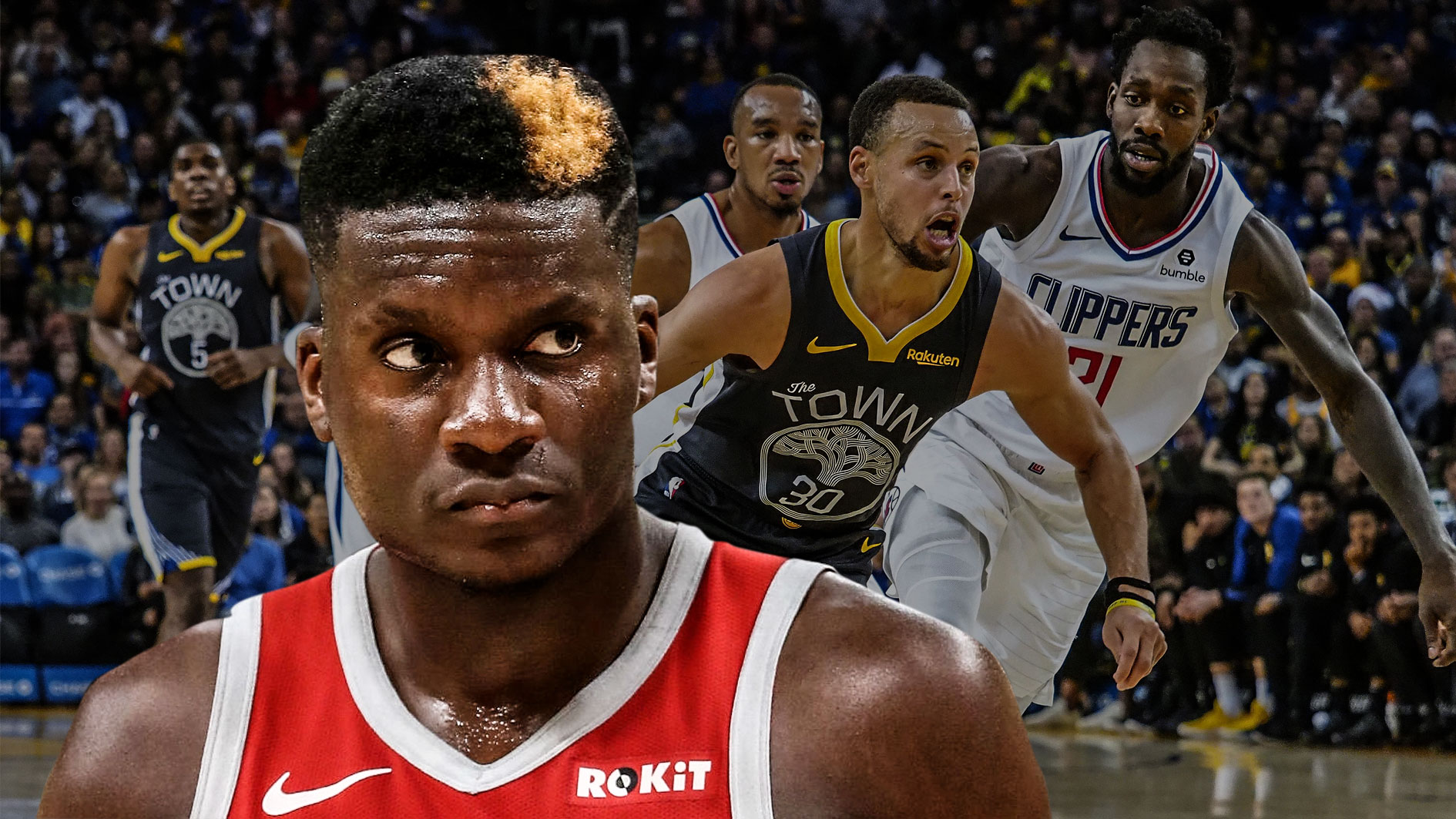
Just minutes after sending the Utah Jazz home in Game 5, Chris Paul looked over at Clint Capela during the postgame press conference. His Swiss center, who practically dominated the lane and rebounding margin in Game 7 of last year’s West Finals, was already giving their next opponent motivation. When Capela said, “That’s what I want, I want to face them,” it was another layer of his confidence that Houston is the better team. With the only playable center on Golden State’s roster being Kevon Looney, you figure Capela was licking his chops at the idea of running it back.
After Houston watched the Warriors’ defense take a meaningful step back throughout the season, there was probably hope that more areas would be open to exploit this time around. What they didn’t foresee was something that’s transpired early on: Steve Kerr’s small-ball tactic is completely eliminating the threat — or at least the one advantage Houston had — of Capela feasting off James Harden’s drives.
It’s certainly possible the Rockets fell into the trap of thinking too much about the series last year, when they didn’t have to plan against the Warriors’ Death Lineup after Game 3. It changed the gameplan for both sides since arguably the best defender on the floor wasn’t able to suit up.
The results after two games in Oracle Arena during the rematch haven’t been pretty for them, even if neither were blowout losses. They find themselves in a 0-2 deficit, forced to win four out of the next five.
So far, it’s been less of Capela dictating what the opposition does and more of the reverse. Houston isn’t converting nearly enough offensively or maximizing his use when he’s on the court, and they are getting eviscerated while trying to defend Golden State with a traditional center. Capela has played 60 of the possible 96 minutes in the first two games. In those minutes, the Rockets have scored just 92.4 points per 100 possessions while allowing 123.7 — being trounced by 31.3 points per 100 possessions when he’s on the floor.
He’s not getting the same looks from a fractured Warriors’ defense that usually results in a lob at the rim, or creating second-chance buckets. He has just nine field goal attempts in two games, putting his average shot attempts per 100 possessions at 7.6 in this series – last year it was 10.4 in the West Finals. While Game 2 was a better individual effort for him and he was more active on the boards, the Rockets were still pummeled by 19 points when he played.
It’s evident why the impact is so small. In terms of Houston’s primary actions, the Warriors starting the Death Lineup gives them multiple perimeter pests to annoy Harden’s screen-and-switch bait. Andre Iguodala and Stephen Curry are doing anything they can at the top to accomplish one of three things. Either force Harden to take way longer than expected to get Curry switched on to him, deny it completely and just keep Iguodala there, or get the ball out of Harden’s hands.
While it can sometimes be dangerous because your defense is scrambling, the Warriors have invited others to make plays off-the-dribble. It’s clear they don’t trust Austin Rivers, Danuel House, or Eric Gordon to adequately set up Capela in the most successful ways near the basket:
In the possession above, Iguodala just decides to ditch Rivers. For a moment, Houston thought it had the switch it wanted. But when Iguodala goes back to Harden and tells Curry to leave, it gives Rivers a brief opportunity. He makes the right play to drive once Curry misses the rotation, but Draymond Green is there for perfect help coverage. This is mostly why the Rockets can’t generate much for Capela — their guards haven’t executed well enough on making the help defender (Green) commit to the drive. In the play above, watch where Rivers decides to pass it off. He was a stride too early, and Green was able to recover perfectly back to the big man.
We see a very similar situation here, except it’s Eric Gordon working out of Houston’s favorite “21” set. Harden initiates the action with a pass to Paul on the wing. Paul then navigates around two screens by Harden and Capela in the midst of Gordon coming around an off-ball screen by Tucker. Once Gordon catches on the move, it’s up to him to make a play:
Even though he gets by Curry after the switch, Gordon completely botches the 2-on-1 opportunity with Capela. Gordon has never been that accurate of a passer, but it’s a play you have to read and time correctly. When the middle man is perhaps the smartest and most versatile defender since Scottie Pippen, you can’t make mistakes like this. Gordon releases the lob after just one dribble, never making Green respect his own drive. Capela had no chance of catching this with the defender in his space.
It’s different from Harden’s penetrations, as his timing is typically perfect on these. However, during the instances where he and Capela were looking at the 2-on-1, Green’s timing has been even more impressive. In these first two games, Green has effectively stunted at Harden inside the floater range, but somehow backpedals fast enough to get a hand on the lob to Capela.
Because of his ability to trick the ball-handler into throwing the pass, Green has played an integral part in Houston turning the ball over more times than usual. The Rockets have coughed it up on 17.6 percent of their offensive possessions to begin this series, which is a far cry from their 13.4 percent rate during the regular season. That’s what has made the Rockets so special offensively since trading for Paul. They became smarter, limited mistakes, and made a boatload of threes.
When you give the Warriors extra transition attempts, it becomes a mess.
For a variety of reasons, Harden likely has to be more assertive in driving all the way to the rim on this Warriors’ Death Lineup. Although Green is an exceptional user of verticality and can disrupt anyone, Harden has to put more pressure on the interior. When the series shifts to Houston, the idea of getting Green in foul trouble or simply opening up more opportunities in the middle by forcing him to stop the drive should be incentivized:
To me, this was Harden’s best play of the series to this point. After calling for the Rivers screen to get a switch, he expertly splits through Curry and Iguodala (coming over the screen) to get into the paint. From there, the euro step gives him a better driving angle on Green, and he actually takes it to him strongly. Notice how much the Warriors are paying attention to Capela here. Klay Thompson smartly comes down to put a body on Capela, preventing him from getting to the dunker’s spot. It allows him to cover Capela while also having enough time to dart out to Paul, who is positioned in the weak side corner.
When Green is on the floor, Golden State is doing everything it can to keep Capela from exploding in this series, and it’s paying dividends. Harden may get a few floaters or layups to fall because of it, but they are trusting his historical percentage in the playoffs to come to light. So far, it has. From 5-9 feet from the rim, Harden is 6-of-32 in the first seven playoff games (18.8 percent). The Warriors will adjust as the results change, but they would rather cut off Capela in the halfcourt completely.
What happens when Green isn’t on the back line of defense and has to switch on the perimeter? Well, for as active and helpful as Durant was in Game 2 defensively, there were still moments where Green’s presence was missed. He’s not nearly as skilled at this particular cat-and-mouse game with Harden and Capela, and it appears the only way Houston can get its big man involved is by Green sitting on the bench or being too far away:
Capela’s impact has also taken a negative swing defensively in this matchup. When the Warriors are clicking on all cylinders, they are tough for any team to handle. There are too many bases to cover, too many screens to think about, and also there’s a (giant) isolation option they have. When Capela is on the floor, Golden State is trying to attack him in many different ways.
If they are getting fatigued from running their routes and trying to get open, they can just have Green set a screen for Durant once the possession starts. If Houston’s mentality is going to continue being “switch everything and we’ll live with the results,” well … you have to wonder if they’re comfortable with this happening. Capela switched onto Durant isn’t as terrible as Rivers, House, or Gordon, but it’s still a disadvantage because of Durant’s ability to create a pocket of space with his handle:
They have also exploited him throughout their favorite sets, one of which is a spin-off of “Head Tap.” This usually begins with Curry cross-screening for Durant to get a post-up, but they can run it with just a direct post feed. Durant has Harden on him in this situation. That would normally mean he’s getting to his own shot since it’s a favorable matchup, right?
Well, Green has Capela on him, and he knows Houston will probably miscommunicate if Green screens off-ball for a shooter. While the ball is being delivered into the post, Curry fakes down the lane only to come around Green on the strong side wing. It gives Capela approximately one second to see it, process it, and get out on the wing. There’s an open three:
Gordon has no way of getting around this screen by Green, and Capela was playing way too far under the action. This is the Warriors’ most-used play, and he has to know what’s coming.
This is just another reason why Mike D’Antoni may elect to go with a smaller lineup in Game 3. While it’s never great to overreact to (close) road games, we already have a 60-minute sample that shows Capela isn’t on the floor during the minutes they’re closing the gap.
The defensive glass should be the one thing that’s going Houston’s way when the Death Lineup plays. With Green at center, the Rockets should be eating up every miss the Warriors give them. Instead, the Curry-Thompson-Iguodala-Durant-Green minutes have resulted in a 29.4 percent offensive rebounding rate. For perspective, that would rank fourth in the league during the season.
The Death Lineup’s offensive rebound rate in the 56 minutes it played in the West Finals last year? 15.6 percent. Pretty much half of what we’re seeing now.
With the Rockets having different bench options this time around, it’s worth sliding in another guard and playing PJ Tucker at center. They are lacking defensive bodies to withstand the switch-heavy defense they like, as discussed in the series preview regarding the loss of Trevor Ariza. So, it really appears the only way Houston has a chance in this matchup is to get hot and outshoot them at home, gaining momentum to tie the series. Inserting Rivers, who was a +10 in his 24 minutes in Game 2, is probably worth testing out.
Facing a two-time defending champion, the list of things that must go your way is already too long. The margins are razor thin in the playoffs every year, but the number of mistakes you can make against a team like this is limited to a small handful. Curry is only 6-of-23 from three and the Warriors are still looking at a 2-0 lead, a cushion you just don’t give them.
So, the Rockets can’t be less than perfect from here.
The post How Clint Capela’s impact has suffered against the Warriors appeared first on ClutchPoints.






